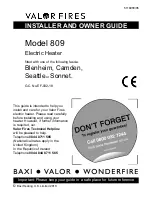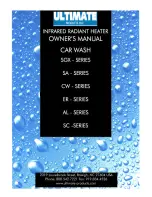
TD SOLUS II:
Installation
16
La
st
r
ev
is
ed
0
5/
20
0
9
Component designations:
1.
Shut-off valve
2.
Pressure-reducing valve (if the
network pressure is greater than
8 bar and there is no pressure-
reducing valve at the building
connection)
3.
Test valve
4.
Non-return valve
5.
Manometer connection with
manometer
6.
Shut-off valve
7.
Safety valve
8.
Drain funnel
9.
Drainage valve
10.
Sanitary expansion vessel, e.g.
water-shock damper
11.
Thermostatic hot water mixer
Safety valve (7):
No dirt traps or other constrictions may be fitted in the
supply pipe.
Close at a pressure drop of 20 % of the response pres-
sure.
To be installed in an easily acessible location, so that it
can be opened during operation. A warning notice with
the following text must be displayed at the safety valve
or at its blow-off line: "For safety reasons, water may
escape from the blow-off line during heating! Do not
close".
Install appropriately to ensure that no-one is endan-
gered by hot water or steam from the valve.
Blow-off line:
The minimum size is the diameter of the safety valve
outlet
Max. 2 bends, 2 m in length
Max. 3 bends, 4 m length possible if one size larger.
Laying with gradients
The drain pipe downstream of the drain funnel must
have at least twice the diameter of the valve.
Water-shock damper:
Thermal expansion of the hot water in the heat exchanger
causes water loss through the safety valve. Optional rem-
edy: Mount water-shock damper downstream of the non-
return valve or at any point in the hot water pipe.
Non-return valve (4):
The requirements pertaining to the fitting of a non-return
valve, and its design (approval), are contained in DIN
1988 and DVGW worksheet W 376.
Pressure reducing valve (2):
In accordance with DIN 3320, a system operating pres-
sure should be assigned to the permitted operating over-
pressure of the hot water heat exchanger. If the pressure in
the cold water supply pipe leading to the solar storage
tank is over 8 bar, a pressure reducer (which has been
tested and approved as compliant with DVGW worksheet
W 375) must be installed to reduce the cold water pres-
sure to max. 8 bar. If mixer taps are used, a centralised
pressure reducer must be fitted.
Drainage valve (9):
Water heating systems must be fitted with a device (usually
at the cold water connection) which facilitates draining the
system as completely as possible without dismantling.
Fine filter:
If the water quality is poor or if the pipelines are old, a
fine filter must be installed upstream of the storage tank
inlet.
Deliming method
If the water hardness is 8° dH or more, rinsing taps are
recommended for the cold water inlet and the hot water
outlet. For use with water high in limescale, limescale ex-
perts recommend limescale conversion or water treatment
processes for all solar heating systems with 14° dH and
upwards (hard water). You can ask your local water sup-
ply company to find out the water hardness. Ask your in-
staller for advice on this matter.
Circulation line:
Connect the circulation line to the cold water connection of
the storage tank and fit a check valve to prevent short cir-
cuit flows of cold water into the hot water network. Oper-
ate the circulation pump for short periods only (minutes) to
prevent high heat losses and a gradual mixing of the stor-
age tank. CONTROL units provide suitable switching func-
tions for this.
8.5.4
Thermostatic hot water mixer (11)
A thermostatic hot water mixer must be installed to restrict
the maximum hot water temperature, as there is no tem-
perature limiter fitted in the storage tank.
8.5.5
Electric heating rod
To install an electric heating rod, break out the pre-drilled
hole in the PS insulating shell and use a sharp knife (spray
the cutting surface with silicone grease) to cut the EPS insu-
lation along the edge of the drilled hole.
After the electric heating rod has been installed, close the
hole with the cover provided for this purpose (delivered
with the electric heating rod).







































